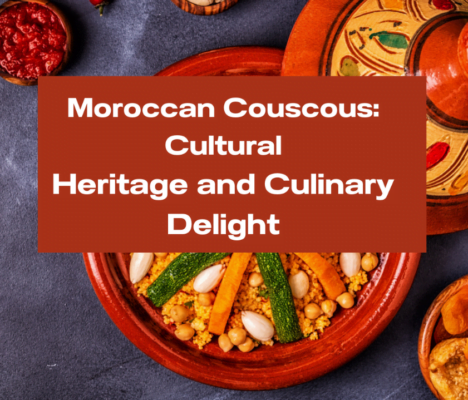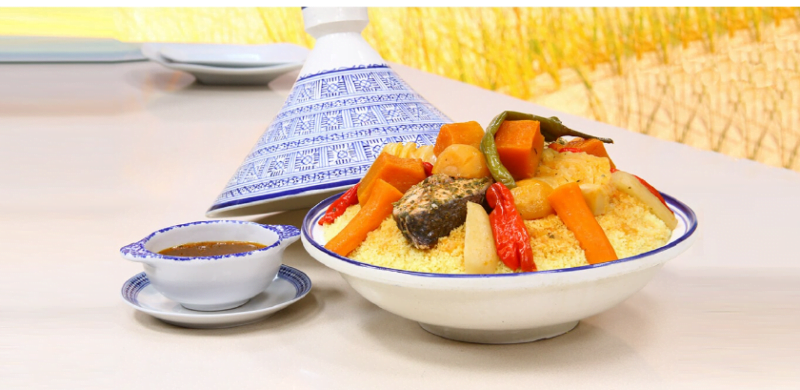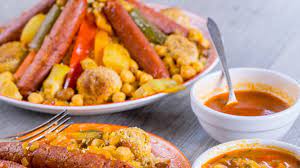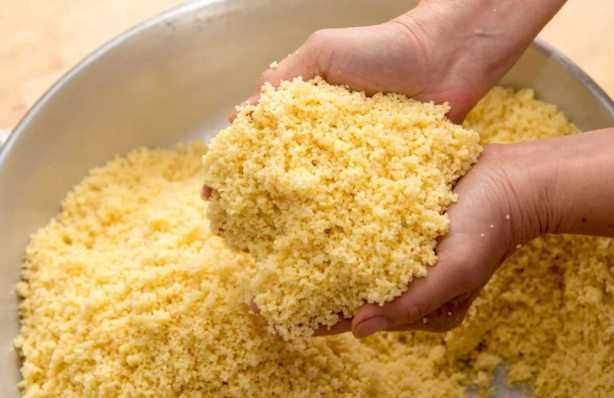A vital component of Moroccan kitchen, moroccan couscous, is more than just a dish—it represents a genuine cultural and culinary legacy that has been passed down through the ages. This famous meal, which has its roots in the ancient Berber tradition, has won over foodies all over the world with its distinct flavor profile and mouthwatering appearance. This essay will provide a thorough review of this culinary marvel that continues to captivate palates and imaginations throughout time and space. We will dig into the fascinating history of Moroccan couscous, reveal its ancient cooking techniques, and examine its international influence.

The Origin of Moroccan Couscous
The region’s cultural past has a significant role in determining the precise origin of Moroccan couscous, Although couscous is frequently linked to North Africa, which includes Algeria, Tunisia, and Morocco, its particular roots inside Morocco are not well known.
That being said, it is generally accepted that couscous has been a staple of Moroccan cooking for generations, most likely dating back to the Berber tribe that originally lived in the area. The cultivation of wheat and barley, two essential components of couscous, is one of the Berbers’ ancient agricultural techniques. Couscous spread throughout North Africa and beyond as commercial routes and cultural exchanges took place, eventually becoming a staple meal not just in Morocco but also elsewhere on the continent. It became an essential component of the culinary landscape due to its adaptability, simplicity of preparation, and capacity to support humans in arid settings.
Moroccan couscous is still loved today as a representation of friendliness, community, and cultural identity. As a reflection of the rich legacy and customs of the Moroccan people, it is frequently savored during festive occasions, religious celebrations, and family get-togethers.
What is Moroccan Couscous?
Made from durum wheat semolina, Moroccan couscous is a staple dish in Moroccan cuisine. It’s frequently adorned with a range of ingredients, including meats (like lamb, chicken, or beef), legumes (like chickpeas), and vegetables (like carrots, zucchini, and turnips). Because this meal is steam-cooked using a couscous steamer, the semolina has a light and fluffy texture. To give Moroccan couscous its distinct flavors, a mixture of spices, including cumin, cinnamon, and saffron, is usually added. Moroccan couscous is valued for its adaptability, depth of flavor, and essential place in Moroccan culinary tradition. It is frequently served as the main course during family dinners or festivities.

Varieties of Moroccan Couscous
There are many different ways to prepare Moroccan couscous, a popular meal with a rich history in Moroccan cooking. Each variation offers a distinct taste experience. Moroccan couscous is diverse and displays the variety of Moroccan cuisine. There are several variations, such as the original classic couscous, the delicious couscous with Tfaya, and the substantial couscous with seven vegetables.
Here are some of the most popular varieties of Moroccan couscous:
- Traditional Moroccan Couscous: Traditional Moroccan couscous made with a range of meats, including lamb, chicken, or cattle, and vegetables, including turnips, carrots, zucchini, and chickpeas.
- Couscous with Seven Vegetables: This dish is known for its abundance of veggies, which frequently include tomatoes, bell peppers, onions, turnips, carrots, and zucchini. It is typically served with chunks of meat and a flavorful sauce.
- Couscous with Tfaya: A combination of sweet and savory, couscous is topped with caramelized carrots, onions cooked in a honey-spice mixture, and lamb or chicken.
- Couscous with Eggs and Almonds: This meal gets its crisp texture and pleasantly rich flavor from the addition of toasted almonds and hard-boiled eggs to couscous.
- Baddaz: Baddaz is a version of couscous in which tiny bits of meat, usually chicken or lamb, are cooked in a hot sauce with vegetables and then served over a bed of couscous.
All of these take on the conventional methods of couscous cooking while providing a distinctive taste experience that highlights the variety of Moroccan cuisine.

Preparation of Moroccan Couscous
The preparation of Moroccan couscous is an ancient tradition that requires time, patience, and meticulous skill. Here are the general steps to prepare this delicious specialty:
- Preparing the Semolina: Start by filling a sizable shallow dish with durum wheat semolina. To thoroughly moisten it, drizzle it with some salted water and stir by hand. To get a light and airy texture, let it rest for a few minutes, and then use your fingers to break up any lumps.
- Steaming: Place the wet semolina in the upper basket of a steam cooker. Water should be added to the couscoussier’s bottom and brought to a boil. Cover the couscoussier after placing the semolina basket on top of it. Steam for thirty to forty-five minutes, stirring the semolina every now and then to keep it from sticking.
- Preparing the Sauce and Ingredients: Make the sauce and toppings for the couscous while the semolina is cooking. This can include meats like lamb, poultry, or beef, as well as vegetables like carrots, zucchini, turnips, bell peppers, and onions. Use a classic spice blend, such as saffron, cinnamon, and cumin, to season the ingredients.
- Assembly and Serving: Transfer the cooked semolina to a sizable serving dish together with the prepared components. Place the meats and veggies on top of the semolina and pour sauce over them. Serve it hot with traditional bread (khobz) and dips (harissa, for example).
- Sharing and Enjoyment: Moroccan couscous is a dish that is best enjoyed in large quantities with loved ones. Savor each bite of this delectable Moroccan dish as you celebrate it together.
You can make a delicious and authentic Moroccan couscous to wow your loved ones and respect Moroccan culinary culture by following these easy but crucial procedures.

To clear things up, Moroccan couscous is evidence of the country’s extensive culinary history. Its preparation is a cultural tradition that has been passed down through the years rather than just a simple culinary method. Every stage in making Moroccan couscous, from the deftly moistening of semolina to the creative placement of meats and vegetables, embodies the meticulousness and care that define Moroccan cooking. Couscous is a food that promotes community and hospitality, drawing people together. Whether savored at festive events or casual family dinners, it promotes a sense of unity and shared experiences.
